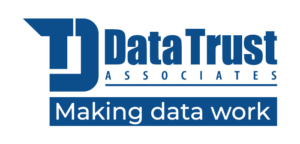Défis en matière de gestion des données
Les capacités de gestion des données ont connu une croissance quasi exponentielle au cours des deux dernières décennies. Avec des solutions de données et d’analyse toujours plus innovantes – souvent pilotées par l’apprentissage automatique et l’IA – la possibilité d’obtenir des informations exploitables à partir des données n’a jamais été aussi présente.
La plupart des organisations souhaitent devenir pilotées par les données, obtenir une culture des données ou être en mesure de rivaliser fortement grâce aux données – pourtant, nous ne voyons que 27 % d’entre elles obtenir une culture des données et 38 % devenir véritablement pilotées par les données.
Pendant ce temps, la plupart des utilisateurs professionnels regardent cela avec un sentiment de désillusion :
« … l’équipe chargée des données est capable d’utiliser toutes ces merveilleuses techniques, mais je ne comprends toujours pas comment elles me facilitent la vie… ».
En tant qu’équipe chargée des données, vous êtes-vous déjà posé la question ?
- Quel est le pourcentage d’utilisateurs professionnels qui utilisent les composants de votre plateforme de données pour consommer des données (au lieu de les obtenir à partir d’une source ou d’un fichier existant) ?
- Combien de fois les utilisateurs professionnels ont-ils demandé à votre équipe de données de les aider à résoudre leurs problèmes ?
- Combien d’utilisateurs ont abandonné Excel ou MS Access et ont utilisé des outils de données pour répondre à tous leurs besoins en matière de préparation des données et de reporting/visualisation ?
- Combien de fois êtes-vous en contact avec les utilisateurs professionnels pour essayer de comprendre leurs besoins quotidiens et les aider à les résoudre grâce aux données ?
Ne vous méprenez pas, il y a certainement des organisations où les utilisateurs professionnels tirent des avantages et de la valeur des données de manière très pratique et où les réponses à ces questions sont positives. Malheureusement, la plupart des organisations ont encore du mal à aller au-delà de l’entrepôt de données et du lac de données, de quelques services clients et d’une série de cas d’utilisation.
Le maillage de données à la rescousse
L’idée du « maillage de données » – une nouvelle façon d’aborder les données et les besoins des entreprises – trouve son origine dans le fossé qui sépare les stratégies des entreprises en matière de données (où l’on promet généralement des gains commerciaux considérables) et la réalité sur le terrain.
les utilisateurs professionnels sont aujourd’hui confrontés à de nouveaux problèmes liés à l’augmentation constante des volumes de données et au manque de données disponibles faciles à rechercher, à comprendre et à utiliser
Alors, le maillage des données est-il la solution à retenir ? Peut-être, mais…
Il manque une pièce essentielle du puzzle
Si vos utilisateurs professionnels ne comprennent pas comment les efforts et les résultats de l’équipe chargée des données peuvent les aider, la mise en œuvre d’une architecture de maillage des données n’atteindra pas son plein potentiel – même s’ils sont d’accord au début avec leurs nouveaux « produits de données ».
Les utilisateurs professionnels doivent comprendre comment ils peuvent résoudre leurs problèmes professionnels grâce aux données – en créant une attraction pour les « solutions de données » au lieu du modus operandi actuel où l’équipe des données propose ses services et ses capacités – avec souvent peu d’impact ou de compréhension de la part de l’entreprise.
La compréhension et l’implication de l’entreprise sont essentielles…
Enfin et surtout, dans le cadre de la compréhension de l’entreprise, nous avons également besoin de l’implication de l’entreprise, ce qui peut généralement être réalisé en appliquant la gouvernance des données.
Après avoir entendu les mêmes défis à maintes reprises au sein de notre réseau, DP-Institute s’associe à une société de gestion de données de premier plan, Data Trust Associates, pour offrir deux cours à un public plus large.
Résoudre les problèmes de l’entreprise grâce aux données
La première étape : Changer la façon dont les utilisateurs professionnels perçoivent l’équipe chargée des données et collaborent avec elle. Idéal pour améliorer la connaissance des données au sein de l’organisation afin de créer un soutien pour les futures initiatives en matière de données
Gouvernance des données et fondements de la gestion des données
Une fois qu’un certain niveau de maturité des données est atteint, ce cours expliquera les bases de la gouvernance des données aux non-spécialistes. C’est un excellent moyen de former les Data Stewards tout en commençant une implémentation de la Gouvernance des Données.
Les deux cours sont disponibles en salle de classe et en entreprise, selon vos besoins.





